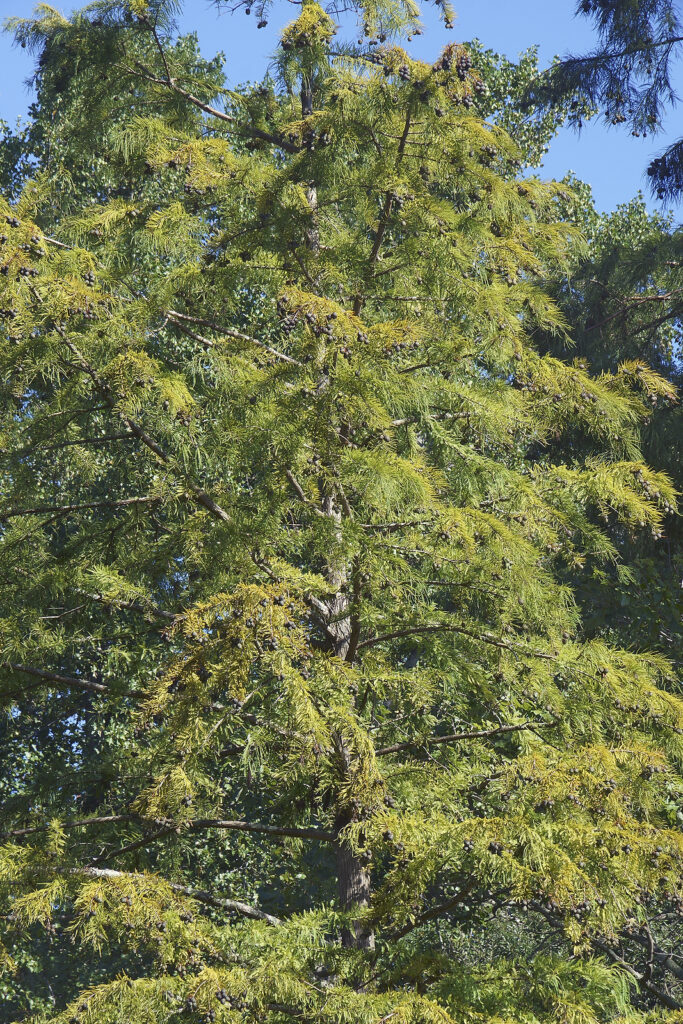Taxodium–commonly called cypress–are upright conical deciduous or semi-evergreen coniferous trees especially suited to very wet or boggy sites. They are native to warm regions but they readily adapt to normal garden conditions and grow stately size in cold climates.
Taxodium grow tall and shaggy. They have cinnamon-colored bark and graceful sprays of short, narrow, flat needlelike leaves. They are slow to fully leaf out in spring with pale yellow-toned green leaves; the leaves turn orange to brown in autumn. They have an interesting winter silhouette.
Taxodium is a genus of three species. They are native to swampy forests and boggy areas from the Southeastern United States to Guatemala.

Get to know Taxodium
- Plant type: Deciduous or evergreen trees
- Growing zones and range: Zones 4 to 9
- Hardiness: Hardy to Zone 4
- Height and width: 70-130 feet (20-40m) tall and 20-28 feet (6-9) wide
- Growth rate:
- Form and habit: Upright, conical
- Foliage: Shaggy, cinnamon-colored bark and graceful sprays of short, narrow, flat, needlelike leaves; leaves are narrowly lance-shaped or linear and bright green, turning rich brown in fall; they alternate radially or in 2 ranks
- Flowers: Inconspicuous greenish flowers
- Fruits: Female flowers produce round, fragrant 1 inch (2.5cm) cones; males occur in groups, females scatter
- Uses: Waterside plantings, landscape, specimen trees, wet or boggy sites
- Garden companions:
- Common name: Cypress
- Botanical name: Taxodium
- Family name: Taxodiaceae
- Origin: River margins from Southeast United States to Guatemala
Where to plant Taxodium
- Plant Taxodium in full to partial sun.
- Plant Taxodium in deep, moist, acid, sandy loam or wet, swampy conditions; they adapt readily to average moisture, and even to harsh mid-western sites, but will drop needles during a drought.
When to plant Taxodium
- Transplant balled-and-burlapped Taxodium in fall or spring.
- Sow seed in containers in a cold frame in spring.

Planting and spacing Taxodium
- Plant Taxodium 20-28 feet (6-9m) apart.
How to water and feed Taxodium
- Give Taxodium much or little water.
- Feed Taxodium with an all-purpose organic fertilizer in spring
How to care for Taxodium
- Taxodium need no pruning other than to remove any competing leaders.
Taxodium pests and diseases
- Although usually problem-free, Taxodium trees may suffer from twig blight, wood rot, or leaf spot.
- Taxodium trees are susceptible to attacks by spider mites and bark beetles.
- Taxodium become chlorotic in alkaline soil.

Taxodium propagation
- Graft Taxodium in late winter and early spring.
- Take Taxodium cuttings in early summer.
Taxodium varieties to grow
- Taxodium distichum, Bald cypress, Swamp cypress, a deciduous conifer that grows to about 70-130 feet (20-40m) tall and 20-28 feet (6-9) wide, Bald cypress has a beautiful, symmetrical shape and delicate foliage that make it an eye-catching choice for a home landscape. The .5 inch (1.3cm) long, narrow, pointed needles are flattened and arranged in two-ranged sprays on delicate green twiglets that drop to the ground in autumn. Needles emerge bright green in spring, mature to gray-green, and turn golden rust-brown in autumn before dropping. (Bald cypress can be distinguished from dawn redwood by the needle arrangement: bald cypress needles are arranged alternately, while dawn redwood’s needles are opposite.) The trunk is very straight, buttressed at the base, and cloaked in pale brown, shredding bark. Found growing naturally along streams or in other wet sites, bald cypress sends up odd, knobby growths called knees from its wide-spreading roots where soil is wet, but not average or dry soil. Cones are round, dark brown and about 1 inch (2.5cm) in diameter. Use this fast-growing tree as a specimen in a lawn or near water, or plant it in a grove in a wet or swampy site on a large property. From North America. Zones 4 to 9.















